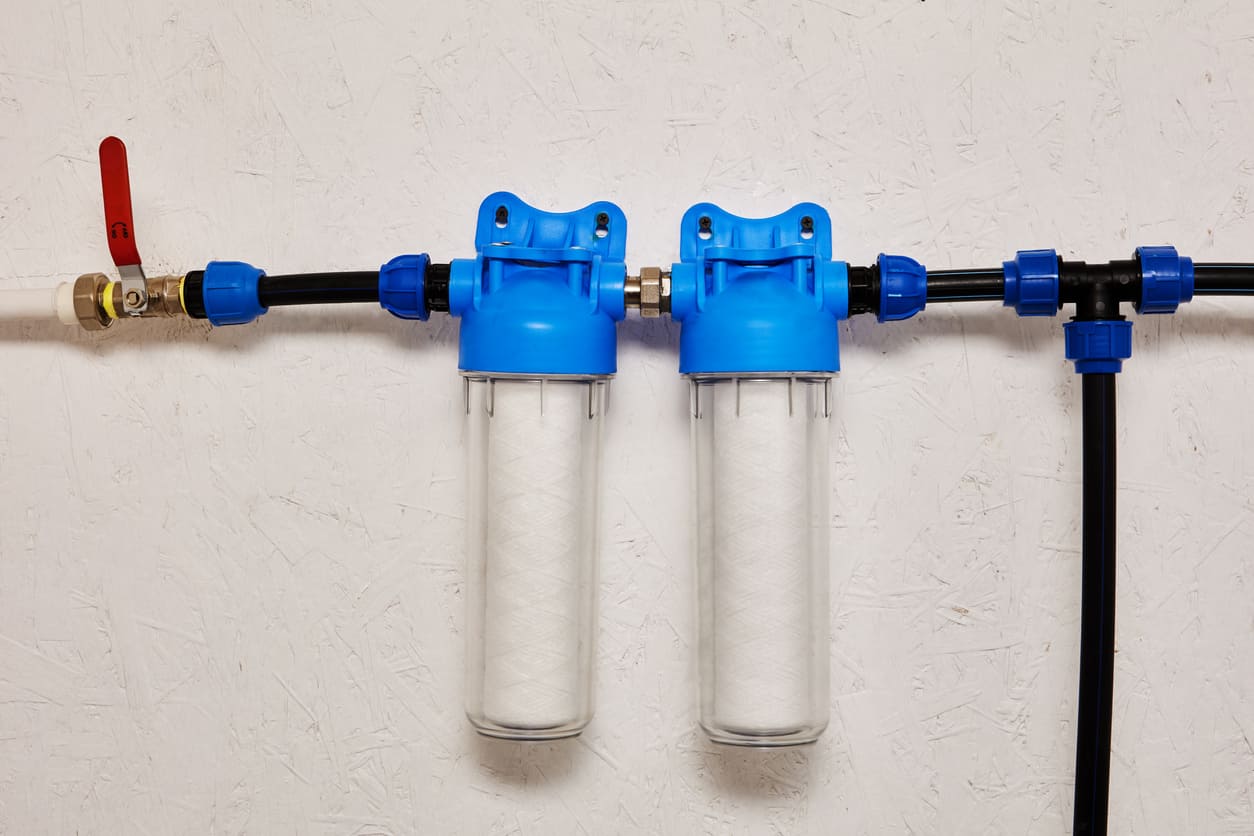The appearance of reddish-brown water together with metallic tastes and sink or laundry stains indicates your well water contains excessive iron. The human body requires iron as a natural mineral, but excessive amounts in drinking water create various problems. You’re in the right place to find a solution.
At Aqua Clear Water Systems, we provide Tennessee, Georgia, and Kentucky residents with dependable water solutions through our expertise in well water treatment. This guide explains how to eliminate iron from your well water supply.
Signs of Iron in Water
The identification process for iron contamination requires confirmation before starting any solution. The following symptoms indicate iron presence in your water supply:
- Discoloration: The primary indicator of iron contamination appears as yellow, red, or brown water that emerges from your tap. The water appears clear at first but turns into reddish-brown after contact with air. The process of iron oxidation leads to this color change.
- Staining: The presence of iron causes permanent reddish-brown and orange stains to appear on plumbing items, laundry items, and dishes.
- Unpleasant Taste and Odor: The presence of iron in water causes a distinct metallic taste that serves as a clear indicator. Iron in water also leads to a strong odor, which can resemble rotten eggs or sewage.
- Clogged Pipes and Appliances: The accumulation of iron sediment inside your pipes, shower heads, and other water-using appliances results in decreased water pressure and possible equipment damage.
- Skin and Hair Issues: High iron content in water leads to oil depletion in skin and hair, which causes dryness and irritation and can produce a red hair color.
Understanding the Different Forms of Iron in Well Water
The identification of iron type in well water is essential for proper treatment, because different forms need distinct methods of removal. The four main forms of iron which exist in well water include:
- Ferrous Iron (“Clear-Water” Iron): The dissolved iron in water remains invisible until it exits the faucet. This type of iron is known as ferrous iron, which scientists call ‘clear-water’ iron. The water changes color when exposed to oxygen because the dissolved ferrous iron transforms into ferric iron.
- Ferric Iron (“Red-Water” Iron): Ferric iron or ‘red-water’ iron has already oxidized into insoluble particles that produce red or yellow discoloration in the water.
- Organic Iron: Organic iron exists as a combination of iron with organic compounds that include tannins. The water takes on yellow or brown colors because of this type of iron, but its removal becomes more difficult compared to other types as organic compounds stop iron from oxidizing correctly.
- Iron Bacteria: The microorganisms known as iron bacteria consume iron to produce reddish-brown biofilms that block pipes while creating unpleasant odors. The presence of these microorganisms makes iron problems more severe, although they do not pose health risks to people.
The First Step: Get Your Water Tested
A professional water test provides the most accurate method to determine both the amount and type of iron present in your well water. A complete water analysis provides iron level measurements and detects common well water pollutants and essential water quality factors, including pH, hardness, and alkalinity.
The collected data enables you to pick the best treatment method which matches your particular requirements.
What is the Best Filter to Remove Iron from Well Water?
The selection of the best filter depends on multiple factors, including iron type, amount, water chemistry, and financial resources. The following section presents the main effective methods for iron removal from water.
Oxidation-Filtration Systems
The most widespread and successful technique for iron elimination exists through this method. The process requires an oxidizing agent to transform soluble ferrous iron into solid ferric iron particles, which become filterable.
- Air Injection/Aeration: The systems use air injection to introduce oxygen into water, which enables oxygen to oxidize iron particles. The oxidized particles become trapped inside a filter media. The system provides a budget-friendly solution for iron, manganese, and hydrogen sulfide (rotten egg smell) removal while requiring minimal maintenance.
- Chemical Oxidation: The process of chemical oxidation employs chlorine, hydrogen peroxide, and potassium permanganate as oxidizing agents to treat iron.
- Chlorine Injection: The water disinfection process of chlorine injection also removes iron bacteria from the water supply.
- Hydrogen Peroxide: The strong oxidizing properties of hydrogen peroxide make it suitable for treating moderate to severe iron contamination while producing no chemical byproducts.
- Manganese Greensand Filters: These employ manganese dioxide-coated media to perform both iron oxidation and filtration operations.
Water Softeners
The ion exchange process in water softeners effectively removes ferrous iron at low to moderate concentrations from water. The resin bed in the system captures iron ions which get replaced by sodium ions when water flows through it.
Water softeners function poorly when dealing with high iron concentrations and ferric iron, because these substances cause resin bed clogging that shortens its operational lifespan. A Kinetico twin-tank system operates as a complete solution for homes that need water softening and low ferrous iron removal.
Sediment Filters
A basic sediment filter provides an affordable solution for treating ferric iron contamination in water supplies. The solid iron particles get trapped by these filters when water flows through them. The filters fail to eliminate dissolved ferrous iron and do not solve taste or odor problems in water.
Reverse Osmosis (RO) Systems
A reverse osmosis system installed under your kitchen sink provides the best possible drinking water quality. The semipermeable membrane of RO systems effectively removes iron along with bacteria, heavy metals, and dissolved solids from water.
The RO membrane requires protection from iron plugging, so it functions best as a finishing treatment when paired with a complete house iron filtration system.
How to Remove Iron From Water Naturally
People who want to know how to remove iron from well water naturally should consider using aeration systems. The air injection oxidation system operates as a chemical-free treatment method which is frequently chosen. The system uses atmospheric oxygen to transform dissolved iron into filterable solid particles without introducing foreign substances into your drinking water.
What is the Cheapest Way to Remove Iron from Well Water?
Sediment filters are the most budget-friendly solution, providing an affordable solution for ferric iron particles. A water softener system already installed in your home can handle small amounts of ferrous iron but needs more frequent maintenance and resin cleaning.
Take the First Step to Iron-Free Water Today
Dealing with iron in your well water can be a frustrating experience, but you don’t have to do it alone. Don’t let iron problems ruin your home and your water. Get in touch with Aqua Clear Water Systems today to schedule your free water test.
For homeowners seeking a long-term, comprehensive approach to clean water, installing whole home water filter systems offers an excellent solution. These systems treat every drop of water entering your home, effectively addressing not only iron but also other common well water contaminants such as sediment, manganese, and sulfur. By ensuring consistent filtration throughout your plumbing network, they help protect your pipes, appliances, and fixtures while delivering safer, clearer, and better-tasting water from every tap.







